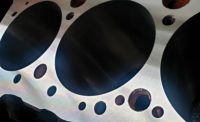Measurement
3D Optical Profiling Breaks the Speed Limit
Today 3D optical profiling can provide an ever-growing range of measurements in medical devices, semiconductors, automotive production, aerospace, materials, machining, and more.

Image Source: Michigan Metrology
Since its development in the early 1990s, 3D optical profiling has been a pivotal technology for high-resolution measurement of optics, semiconductors, medical devices, and precision machining. In its earliest forms, that high resolution came with a tradeoff of small measurement areas or slow measurement times. Recent developments have extended both the lateral and vertical ranges, making it possible to capture high-resolution surface texture measurements over many square millimeters, in a matter of minutes.

Phase Shifting Interferometry for smooth surfaces
In the 1980s and early 1990s, advances in computing power and optical component technology made it possible to use high-resolution interferometry for production measurement. The earliest systems relied on Phase Shifting Interferometry (PSI). In a PSI system, a semi-monochromatic light beam is split and recombined to measure surface error compared to a reference surface. PSI made it possible to measure smooth optical/polished surfaces, with average roughness (Ra, or Sa) values in the 50–100 nm range. However, the systems were incapable of measuring rougher surfaces or taller steps, limiting their utility for most commercial/industrial production measurement needs.
Vertical Scanning for rougher surfaces and taller steps
Over the next several years, vertical-scanning interferometry (VSI) was developed, incorporating a white light source to measure rougher surfaces and higher steps. The new systems provided sufficient resolution and vertical range to measure surface roughness for applications in hard drive manufacturing, semiconductors/MEMs, automotive, aerospace, etc.
But a challenge persisted: achieving higher lateral resolution required higher magnification microscope objectives, which resulted in smaller measurement areas (Figure 2). The small measurement area (field of view, or FOV) meant that more measurements were required to sufficiently sample surface roughness. And, critically, the small measurement area was insufficient to measure longer spatial wavelength waviness at all. Older technologies such as stylus profilometry were still necessary to measure long spatial wavelength shapes.

Stitching creates large, high-resolution measurements
To solve this issue, optical profiler manufacturers developed “stitching” techniques that merge many measurements into one single, high-resolution measurement. A stitched measurement captures high-resolution data over a sufficiently large area to characterize short spatial wavelength roughness and longer spatial wavelength waviness.
Figure 3 shows a stitched measurement of an automotive dashboard cover. In this application, the shorter spatial wavelength roughness helps eliminate blinding glare while the waviness helps to hide wear and tear. The stitched measurement reveals both aspects of the texture.

But combining high resolution and a large measurement area led to new tradeoffs. Stitching was time-consuming, and the very large, stitched datasets could easily overwhelm a computer’s capability to analyze and store the data. When it came to lateral resolution, measurement area, and measurement speed, inspectors could only have two out of three.
The tradeoff is no longer a tradeoff
Today’s 3D optical profilers, however, have overcome many of these limitations. The current crop of instruments can acquire high-resolution, large area measurements in a fraction of the time of previous instruments, due to improvements on several fronts:
- Increased computer power has improved data acquisition and analysis time
- Higher scanning speeds make large stitches possible
- Advanced/proprietary scanning and stitching algorithms improve data quality
- Larger storage devices and cloud-based storage simplify handling of large datasets
- Faster, more precise stage hardware has improved the ability to align adjoining measurement data
- Improved acquisition techniques enable an operator to optimize stitching speed, especially for complex surfaces
- Better data analysis tools make it easier to isolate and interpret structures within the data.
Figure 4 shows a wear scar on a porous surface. Imaging this highly porous surface requires high resolution, and stitching is required to capture the entire wear scar. Newer data analysis tools (in this case, morphological filtering, courtesy Digital Metrology Solutions) make it possible to extract the wear scar from the surrounding porosity and to accurately measure its depth and volume. Remarkably, stitched measurements such as this one can now be accomplished in just a few minutes.

The current “state of the art”
Figure 5 is an excellent example of what is currently possible with a 3D optical profiler. This data shows a wear scar from an ASTM G65 wear test coupon, as used in the oil and gas industry. The coupon contains tungsten carbide tiles in a brazed matrix. This stitched dataset, measuring nearly 21 mm x 42 mm, consists of over 300 individual measurements acquired automatically over a few hours. A serpentine stitching pattern, auto-focusing options, and advanced stitching techniques helped make it possible to measure the deep pits and steep slopes of this sample. Such a large, complex measurement would have been virtually impossible just a few years ago, but it can now be accomplished as a matter of course.

Metrology manufacturers continue to improve 3D optical profiler hardware, software, and measurement techniques. As an example, in recent years manufacturers have developed techniques that combine the resolution of PSI measurement with the vertical range of VSI, as well as algorithms that can automatically select the best measurement mode based on the surface itself.
3D optical profiling now makes it possible to acquire and analyze data with lateral resolution on the order of 1 micron over measurement areas 10s of square millimeters large, with height resolution of 1 nanometer or better. This impressive capability makes 3D optical profiling an enabling technology for an ever-growing range of measurements in medical devices, semiconductors, automotive production, aerospace, materials, machining, and more.
Looking for a reprint of this article?
From high-res PDFs to custom plaques, order your copy today!





